LADYS FASHIONS INFORMATION PAGE
NO HOOPS IN THE MILL!
This bill was posted in the Woolen Mill of Michael Asselstine
Location Unknown at the time of this writing.
D R E S S
October 9th, 1860
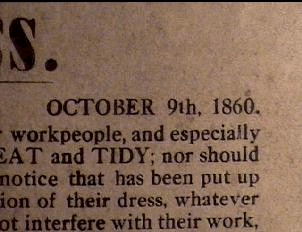 It is always a pleasure for us to see our workpeople, and especially our comely young women, dressed NEAT and TIDY; nor should we, as has already been declared in a notice that has been put up earlier, wish to interfere with the fashion of their dress, whatever it may be, so long as their dress does not interfere with their work, or the work of those near them in our employ.
The present ugly fashion of HOOPS, or CRINOLINE, as it is called, is, however, quite unfitted for the work of our Factory. Among the Power Loomsit is almost impossible, and highly dangerous; among the carding and other machines it greatly impedes the free passage of Overseers, Wasters, &c., and is inconvenient to all. It is equally inconvenient, and still more mischievous, by bringing the dress against Spindles, while also it sometimes becomes shockingly indecent when people are standing upon the sliders.
It is always a pleasure for us to see our workpeople, and especially our comely young women, dressed NEAT and TIDY; nor should we, as has already been declared in a notice that has been put up earlier, wish to interfere with the fashion of their dress, whatever it may be, so long as their dress does not interfere with their work, or the work of those near them in our employ.
The present ugly fashion of HOOPS, or CRINOLINE, as it is called, is, however, quite unfitted for the work of our Factory. Among the Power Loomsit is almost impossible, and highly dangerous; among the carding and other machines it greatly impedes the free passage of Overseers, Wasters, &c., and is inconvenient to all. It is equally inconvenient, and still more mischievous, by bringing the dress against Spindles, while also it sometimes becomes shockingly indecent when people are standing upon the sliders.
FOR ALL THESE REASONS
We now request all our Hands, at our Factory to leave HOOPS AND CRINOLINE at home when they come to the Factory to work; and to come dressed in a manner suitable to their work, and with as much BECOMING NEATNESS as they can.
And OVERSEERS at all the Floors are hereby charged to see that all the Hands coming to work are thus properly dressed for factory work--without Hoops or Crinoline of ant sort; OVERSEERS will be held RESPONSIBLE to us for strict regard to this regulation.
Licking Bobbins.
When a Bobbin is fastened off, it has been common practice to touch the end with the tongue to smooth it down, and there is no harm in that.
But out of this practice has arisen another practice, both nasty and mischievous, of licking the Bobbins all over to make them weigh heavier.
And to put an end at once, and altogether, to this nasty and mischievous practice of licking Bobbins, we now make it
A RULE
Not to touch the Bobbins with the Tongue at all; and OVERSEERS are hereby authorized to enforce this rule by Forfeits.
MICHAEL ASSELSTINE
WOOLEN FACTORY.
BUTTONS ON DRESSES
From the book,
ANNIE HARPER'S JOURNAL. Page 14
From her personal experiences, written 11 years after the war.
I Remember giving the second year of the war one hundred dollars for fifteen yards of spring silk, also one hundred dollars for three carbuncle studs and a pair of sleeve buttons.
Beadle's Guide to Dress Making & Millinery, page 30.
In regard to the use of buttons and button holes over hook and eyes Mrs. Pullan has this to say,
"Buttons and button holes are still neater and more secure; but it is not every material which is suitable for button holes. Such as fray out much will not do; and very thick materials are clumsy."
Beadle's Guide to Dress Making & Millinery, Page 33.
"When the body is closed with buttons it is a good plan to put two or three hooks and eyes within, at the lowest part to lessen the strain on the button holes."
Beadle's Guide to Dress Making & Millinery, page 35.
This is said regarding low bodices and buttons.
"Low bodies are sometimes laced up the back; but hooks and eyelets are better, with small buttons set fon fro ornament and one really securing the top."
Beadle's Guide to Dress Making & Millinery, page 40.
" Buttons are much better than hooks for a wristband, as the latter are apt to catch in trimmings or lace. But the very best and neatest fastenings of all are the Ive's patent sleeve-buttons, which answer equally on lingerie or dresses and last a lifetime."
Beadle's Guide to Dress Making & Millinery, page 56.
"The mode of fastening a cloak varies with the fashion. Undoubtedly the most comfortable for cold wether is with large buttons and button holes but sometimes double buttons and loops are employed."
From the book;
A BLOCKADED FAMILY IN SOUTHERN ALABAMA by Parthenia Antoinette Hague
Speaking of her life as a teacher in rural southern Alabama where she spent the entire period of the war, written 20 years after the war, Page 68.
The buttons for our dresses were our next concern. Substitutes for buttons and material for making them were many and varied. It was something bewildering for us to determine, finally what sort to buttons we should adopt. The buttons we made of wood were good for heavy goods. Sometimes we would polish them with sand paper and varnish them with a little copal varnish. Our buttons once polished and varnished exhibited some likeness to those we bought before the war.
Others were made of cloth cut round, stacked in as many plies as needed for firmness with the outside worked with a heavy button hole stitch.
Persimmon seeds were also used for buttons with very good success.
The common gourd and homemade paste board was used to make buttons.
Regarding paste board and gourd; We have often cut them in different shapes and sizes. We would have them round, oval, square or diamond shaped, then cover them neatly with cloth to match whatever material was to be used for the dress or basque.
(She goes on to list several other choices.)
From the book;
A BLOCKADED FAMILY IN SOUTHERN ALABAMA by Parthenia Antoinette Hague
Speaking of her life as a teacher in rural southern Alabama where she spent the entire period of the war, written 20 years after the war, Page 71.
It was then fashionable to place straps on the shoulder seams of ladie's dresses, with generally from four to six buttons on the straps.
Pockets
Pockets are the norm and not the exception; at least according to Mrs. M. M. Pullan, authoress of "Beadle's guide to Dress making and Millinery" first published in Nov. of 1860.
On PAGE 15 Mrs. Pullan gives detailed instruction on where and how to place the pocket into the dress and makes no mention of, "should you decide" or "if you would like". It reads very plainly, "YOUR POCKET GOES HERE" And is mentioned a total of 8 times over the space of just 3 pages.
Beadle's Guide to Dress Making & Millinery, page 49.
In regard to dressing gowns Mrs. Pullan says this;
"Pockets are indispensable. and we incline to think that when made ornamentally, with trimmed exterior flaps they are more dressy than the ordinary kind."
Beadle's Guide to Dress Making & Millinery, page 53.
In regard to traveling clothes Mrs. Pullan has this to say;
"Jackets from the facility which they offer for having the great number of pockets, as well as from keeping the person warmer than round bodies do, we think, continue fashionable for traveling. Pockets should be made in the waist seams so that they will hold the pormonnaies on one side, and the railway tickets and so fourth on the other."
A little further down the page,
"We confess to a prejudice in favor of abundance of pockets in every garment destined for the traveling wear and in a basquine should have breast pockets in the interior as well as outside ones below the waist with flaps to them in the ordinary way."
GARIBALDI SHIRTS FOR LADIES
Petterson's, April 1862, page 348.
There have been but few new goods imported this season, economy being the order of the day. Old dresses are made to look like new, as nearly as possible. Skirts worn out at the bottom are renewed or lengthend by a bias band, plaiting or ruffle, or silk of black or some color contrasting well with the dress. in this way two old dresses often make on stylish new one. The antiquated bodies, or worn out bodies are discarded, and jaunty Zouave jackets with white shirt bodies and sleeves, or garibldi shirts take there place. As the season advances, pique or Marseilles will take the place of silk or flannel for these articles.
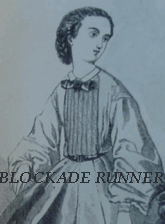
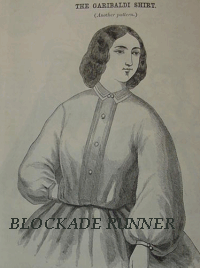
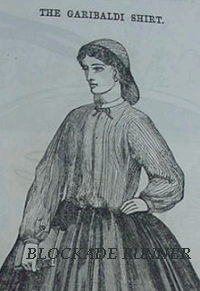
All Three of the images above are Godey's Ladys Book, 1862. From Left to right are April, March and January.
FIRE RETARDENT DRESSES
My grandmother was a great story teller, and I vividly remember her story of a childhood friend who at the age of 9 years was burned to death. The child had been helping her mother attend to a wash pot of clothes boiling over an open fire in the yard as was the custom in the Tennessee backwoods in 1906. The child eased closer to the fire to stir the pot when the hem of her cotton dress brushed the flames. She was instantly set alight and died that day. Now my grandmother related a much more detailed, heart rendering description that I shall spare you from, but I think you understand just how important fire safety is around a camp fire.
Here are a few tips, from period sources that may be of some use to you.
From the book, "INQUIRE WITHIN UPON EVERYTHING", first published in 1856 by Houlston and Stoneman in Great Britain.
Page 3, Tip # 28.
PREVENTION OF FIRES, add one ounce of alum (Alum is inexpensive and available at any good drug store.) to the last water used to rinse children's dresses and they will be rendered uninflammable, or so slightly combustible that they would take fire very slowly, if at all, and would not flame. This is a simple precaution. which may be adopted in families of children. Bed curtains, and linen in general, may also be treated in the same way.
We will list any other tips on this matter that come to light. Feel free to submit yours. We will be happy to list it here and will happily give you the credit.
Calico
While you are doing your research please remember one thing. Any one source is just that, "ONE SOURCE". Some things are very regional, or they may change dramaticly from one year to the next. Such is the case here. I have listed the "ANTI CALICO" comments first but read on and you will find some very "PRO CALICO" comments listed farther below.
In the opinion of the "upper crust",
Calico is a very cheap material. Used by the lower classes and for linings, at least that is my interpretation of what I have read.
Read the quotes listed below and decide for yourself.
In Beadle's guide to Dress Making and Millinery (Nov. 1860)
The authoress Mrs. M. M. Pullan, fashion magazine editress, has this to say;
"The handsomest dress looks ill if the corsage (bodice) does not fit nicely; the commonest calico, if this essential part is managed artistically, looks well."
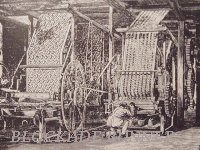 Beadle's page 47.
Beadle's page 47.
"But foulard silks with plain spots or set patterns on them certainly are not pretty. They often have more the appearance of calicoes. "
In Beadle's guide to Dress Making and Millinery (Nov. 1860)
The authoress Mrs. M. M. Pullan, fashion magazine editress, page 59, has this to say;
"Cut out a model in old lining calico or any waste material."
From the book;
A BLOCKADED FAMILY IN SOUTHERN ALABAMA by Parthenia Antoinette Hague
Speaking of her life as a teacher in rural southern Alabama where she spent the entire period of the war, written 20 years after the war, Page 91, 92, 93.
Edited for length.
A steamer had run the blockade and the city of Eufaula (Al.) had secured some bolts of prints and other notions.
A few bolts of English prints, some ladies straw hats, a bolt or 2 of fine bleached stuff, some calico, and a few pair of ladies shoes.
We had fondly imagined ourselves satisfied with our home made cloth, and had said of it, as David of the sword of Goliath, "there is none like that; give it me". We had little dreamed that our firmness would so suddenly collapse before about three bolts of calico, yet so it was, for when the merchant unfolded to our view his brand new prints, looking so fresh and novel we four had nine yards apiece cut off, paying twelve dollars per yard for it.
The background was a pale blending of violet with white; the foreground was dotted with violets of deep purple color.
I sent a small scrap of it to my relatives in Georgia. Small scraps of calico were sent in letters to friends and relatives, so rare were new calicos.
THE SHELBYVILLE TN. SESQUI-CENTENNIAL
Page 75.
Confederate General Born in Shelbyville
Henry Brevard Davidson, a Confederate General who had a flair for the dramatic, took command of a brigade of Gen. Wheeler's Cavalry at Rome Georgia in 1864. Davidson requisitioned every yard of red calico from every store in Rome and he and his men decorated their horses with it. The moral-boosting effect of these gaily bedecked mounts can easily be imagined.
From the book,
ANNIE HARPER'S JOURNAL. Page 14
From her personal experiences, written 11 years after the war.
Mid page, Mrs. Harper mentions very briefly that calico was in short supply in Natchez.
(I paid) "two dollars and a half a yard for calico."
From the book,
ANNIE HARPER'S JOURNAL. Page 22
From her personal experiences, written 11 years after the war.
Until the lines were permanently closed, country people from great distances were pouring into town, to get a share of the tempting wares of sutler's shops and trade store. For this they had to get permits from the provost Marshall specifying what they wished to take back.
This they would show to the picket guard whose duty it was to see that articles and permit corresponded. But alas! How often was double, yea quadruple carried out for which no permit appeared.
A lady would go shopping. The accommodating clerk would carelessly insinuate a piece of the loveliest Confederate grey cloth, under a piece of calico.
"Oh if only I could get some of this." "Get anything you wish madame, but can you carry it out?"
Thence to a friend's would the lovely woman skip, baste up her grey into a petticoat, here flannel for a bustle, hang her pistols inside of here hoop skirt, put cavalry boots on her little feet, and thus attired smile serenely at the picket, while he inspected her coffee, sugar and calico.
From Catherine Deveraux Edmondston's Dairy
Looking Glass Plantation, Aiken S.C.
Oct. 19, 1862
We can't get muslin dress for less than $6 or $8 dollars a yard; calico $1.75, etc.
From The Civil War Diary of Ellen House
In Union occupied Knoxville Tenn. Feb. 29, 1864
Page 109.
Raining all day. I commenced making my other calico dress.
Sewing Machines
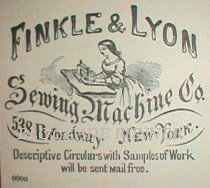 From Beadle's Dime guide to Dress-Making and Millinery by Mrs. Marion M. Pullan---Published Nov. 1860.
From Beadle's Dime guide to Dress-Making and Millinery by Mrs. Marion M. Pullan---Published Nov. 1860.
Page 10 of the introduction.
"Indeed scarcely any dress maker is now without a Wheeler & Wilson however small her establishment."
The photo to your right of the Finkle & Lyon sewing machine ad appeared in Frank Leslies Illustrated Newspaper on Nov. 23, 1861. It ran again on Dec. 7, 1861, in the same publication.
PATENT OFFICE FOR THE YEAR OF 1860
In the year 1860, the U.S. Patent Office issued 67 new patents for Sewing Machines and or the improvements of Sewing Machines.
From the book;
A BLOCKADED FAMILY IN SOUTHERN ALABAMA by Parthenia Antoinette Hague
Speaking of her life as a teacher in rural southern Alabama where she spent the entire period of the war, written 20 years after the war, Page 58.
Hats were made of cloth too, I remember one in particular of gray jeans, stitched in small diamonds with black silk thread. It was as perfect a hat as was ever molded by the hatter,
but the oddness of that hat consisted in its being stitched on the sewing machine with silk thread. All sewing machines in our settlement were at a stand still during the period of the war, as our home made thread was not suited to machines, and all sewing had to be done by hand.
In Beadle's guide to Dress Making and Millinery (Nov. 1860)
The authoress Mrs. M. M. Pullan, fashion magazine editress, page 47, has this to say;
Both in France and England elegant dressing gowns are confined strictly to the higher classes, the wealthy and the noble. Here every lady in ordinary life has handsome morning wrappers for summer and winter.
We cannot help thinking the fashion a pretty one; and to be glad to encourage it, even if it be somewhat luxurious; especially as the universal use of the sewing machine enables us to indulge, at the trifling expense in such dainty robe skirts."
In Beadle's guide to Dress Making and Millinery (Nov. 1860)
The authoress Mrs. M. M. Pullan, fashion magazine editress, page 53-54, has this to say;
"The lining being laid evenly on a large table or on the floor the wadding is laid over it and tacked on with long stitches in every part. It is then quilted by the sewing machine in diamonds or any other pattern."
In Beadle's guide to Dress Making and Millinery (Nov. 1860)
The authoress Mrs. M. M. Pullan, fashion magazine editress, page 61-62, has this to say;
"We have spoken of Walter Evans & Co's. Boars Head cotton. This is a very celebrated English Manufacture, which for its peculiar excellence has been chosen as the standard material in all the book tending of ornamental work. Since the popularity of the sewing machine in America the same firm manufactures a spool cotton expressly for machines which has had certificates of excellence from Douglas & Sherwood, the celebrated skirt manufacturers; Wheeler & Wilson; Moody, the shirt maker and other leading firms."
From the book,
ANNIE HARPER'S JOURNAL. Page 11
From her personal experiences, written 11 years after the war.
How our soldiers were fed and clothed.
The Court house and other public buildings were turned into sewing rooms, where the ladies daily gathered to sew for the soldiers. The experienced matrons cut out the work to be distributed to the sewing machines at work in the room, also to those who came for a supply to be completed at home. Vast quantities of clothing were made in an astonishingly short time.
Godey's Ladys Book
Nov. 1860 Page 463.
The sewing machine should be here named as the completement of the art of needle work. It , the machine, will do all the drudgeries of sewing, thus leaving time for the perfecting of the beautiful in woman's handiwork. We have dwelt often on this wonderful invention, and wish it were possible to interest all our readers in the new romance of needle work.
ADVERTISEMENTS FOR SEWING MACHINES
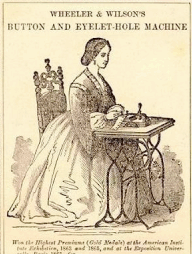 The photo to your right is the upper portion of a "Trade Card" as they are known in the advertising business.
The photo to your right is the upper portion of a "Trade Card" as they are known in the advertising business.
Wheeler & Wilson's button hole & eyelet machine, "Winner of the Gold Medal at the American Exhibition 1863".
This advertisement appeared in the back of the 1855 Ladies Almanac, Business Directory for Boston Mass.
"SEWING MACHINES - B. Nichols and Co....33 Hanover Street. Prices from $75. to $150."
Godey's Lady's book and Magazine Dec. 1863 page 596.
"The publishers of the Saturday Evening Post will give any person sending in 30 subscriptions to The Post and $60. one of Wheeler & Wilsons celebrated sewing machines."
GODEY'S LADY'S BOOK, JAN. 1861
On the last page of the Magazine Wheeler& Wilson has a 2/3 page advertisement. I wonder just what were their rates for such an ad? I would wager that such an ad would be equal to a years wages for many workers of the day.
SEWING MACHINE FACTS
SINGER SEWING MACHINE CO.
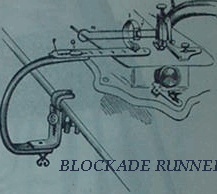 "By 1860, Singer Sewing Machine Company was the largest producer and distributor with over 110,000 machines that year."
Source, Sewing Tools & Trinkets. A collectors guide by Helen Lester Thompson. Printed by Collector Books 1997.
"By 1860, Singer Sewing Machine Company was the largest producer and distributor with over 110,000 machines that year."
Source, Sewing Tools & Trinkets. A collectors guide by Helen Lester Thompson. Printed by Collector Books 1997.
The image to your right is an advertisement that appeared in Godey's Ladys Book in Aug. of 1862. It is for a "tucking" attachment for your sewing machine.
GROVER & BAKER made over 500,000 machines from the early 1850s to the late 1870s.
From "Encyclopedia of Early American Sewing Machines" by Carter Bays, published 1993.
WHEELER & WILSON made an estimated 3000 to 4000 sewing machines from 1851 to 1856, their next model is estimated to have sold over 1 MILLION MACHINES from 1856 through 1875.
From "Encyclopedia of Early American Sewing Machines" by Carter Bays, published 1993.
From the Magazine,
THE MOTHER'S JOURNAL, June 1859, Back Cover.
Premium Sewing Machines. Geo. B. Sloat and co. Two thread lock stitch sewing machines.
To Tailors. To Families. To Dress Makers. To Shirt Makers.
And to all others who require a good sewing machine, either for family or Manufacturing purposes, are invited to call and examine our New Style Machine, or send for an illustrated circular.
SLOAT'S PATENT ELLIPTICAL MACHINE $60.00
BRADSHAW'S PATENT IMPROVED SHUTTLE MACHINE $65.00, DOUBLE TOP $70.00
Twenty different patents dating as far back as 1848 owned by this company.
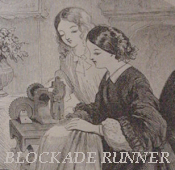 Sales Room, No. 480 Broadway, New York.
Sales Room, No. 480 Broadway, New York.
A LITHO FROM GOODEY'S
Take a look at the edited photo of a the lithograph that appeared in Godey's
February issue of 1863 on page 215. A happy home scene with the Misses sewing away on her new sewing machine. Not visible here but in the original lithograph (as seen in the magazine) there is a copy of Goodey's laying on an ottaman next to the sewing machine, it is open, and turned to the fashion plate page in order to make a better copy of the dress being sewn.
CIRCUMFERENCE OF A DRESS
Beadles Guide to Dress Making and Millinery, Nov. 1860. Page 14.
Mrs. Pullan has this to say regarding he circumference of dresses.
At the present time a skirt should be, at least, four and a half yards round the bottom; and this is not sufficient for thin or transparent materials. It is ample, however for silks; and these are frequently made with the skirts gored so that they are much less at the top. it does not, however save much of the material.
Seven breadths of the ordinary twenty inch wide silk are sufficient for a skirt, but not quite as ample as fashion has demanded. It is better to put in eight if possible. If necessary, one can be readily taken out afterwards, and employed in repairing or altering the body.
From the book;
A BLOCKADED FAMILY IN SOUTHERN ALABAMA by Parthenia Antoinette Hague
Speaking of her life as a teacher in rural southern Alabama where she spent the entire period of the war, written 20 years after the war, Page 92.
"It was something over a yard wide, and as we knew nothing of the ruffling, puffing, plaiting, tucking or shirring of overskirts or polonaises outside the blockade, nine yards were amply sufficient for a dress."
TO GATHER OR TO PLAIT?
Beadles Guide to Dress Making and Millinery, Nov. 1860. Page 20.
Mrs. Pullan has this to say regarding whether to gather or to plait.
The mode of setting the skirt on the band or waist depends entirely on the prevailing fashion. Sometimes it is to be gathered all around; sometimes it is set in plaits in front, and gathered at the back only: at present, the mode is to set it on in large box plaits.
Whatever style is chosen. the whole skirt should be arranged before any part is sewed to the waist; and when gathers are employed they should be gauged down by a second line of gathering half and inch or so below that at which it is to be sewed on.
Box plaits, it must be remembered are plaits or folds to the right and left, from a center; when a great fulness has to be set in a small space, a second, or even a third fold is made under each of those upper ones; and we then speak of double, or treble box plaits.
A plait, generally, is a fold in one direction only.
THE COLOR RED!
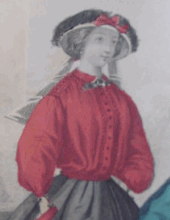 The EVIL COLOR RED, or at least that is how many of our fellow Civil War enthusiast like to portray it. The fact of the matter is nothing could be further from the truth.
The EVIL COLOR RED, or at least that is how many of our fellow Civil War enthusiast like to portray it. The fact of the matter is nothing could be further from the truth.
It's just another Hollywood, Gone With The Wind, Moonlight and Magnolia's MYTH!!!
While there is some basis for it, and ladys may not have refered to "their dress" as being red, they never the less wore every shade of the color you can imagine.
The origin of which I have "almost" pinned down, at least to my satisfaction.
I have a very good lead on where to obtain a hard copy of the information I have listed below and I will post the source here as soon as I have it in hand.
Charleston South Carolina during the colonial period, then as now was a busy sea port. A busy sea port with lots of sailors with money burning a hole in there pocket.
And after a long Atlantic crossing even the cabin boy is starting look kinda cute.
So just guess what the good city had an over abundance of, If you guessed prostitutes you are correct.
Give yourself a cookie.
In fact during this period there were so many of them that the good women of Charleston went to the town fathers and demanded that they do something, anything to somehow separate them, from us.
We can only guess that some of the town's women were getting a little more attention than desired from drunken sailors.
The town fathers in there infinite wisdom did proclaim that from that day forth all ladies who implied the "trade" must wear RED SHOES!
That's ONE CITY during ONE TIME period and the rest is history.
I will list for you below multiple examples of Ladies of the Civil War Era wearing
RED, SCARLET, CRIMSON, GARNET, ETC. ETC.
In the discription of the red garibaldi shirt pictured above the color is refered to as "Rose Sublime", however, a rose by any other name would still be just as RED.
If you are still unconvinced that I am correct, well I hope you and Mrs. Mitchell are very happy together.
I will also list any ANTI-RED (or bright colors in general) information that I find, as in the paragraph below.
From the book;
Ladies Domestic Economy & Housekeeper's Guide, Published anonymously in 1854.
In the chapter, Etiquette for Ladies and Gentlemen, on the topic of dress, the author has this to say about the color of dresses.
The most elegant dresses are black or white. Common modesty will prevent indecent exposure of the shoulders or bosom. A vulgar girl wears bright and glaring colors.
Remember, this book was written anonymously and after reading it completely and comparing it to other books on the same subject, during the same time period, I can only draw one conclusion.
While much of the information offered by this book is "in sync" with the contemporaries of the day, The person who did write this book would have been considered a "prude" even then. Of course that is only my humble opinion.
MAGGIE LINDSLEY'S JOURNAL
Nashville Tenn. Nov. 24, 1864, page 23.
Walked into town this morning to see about several dresses to be made-a purple silk, a crimson, and a black silk.
THE WAR TIME JOURNAL OF A GEORGIA GIRL.
April 11, 1865
The Cuthbert Thespian Corps gave Richelieu at the theater this evening, for the benefit of the hospitals. Dr. Robertson acted the part of De Mauprat, and I dressed him of the occasion in the velvet cloak I bought from Mrs. Sims, and sleeves of crimson silk that had been the trousers of a Turkish costume that sister wore at the fancy ball in Columbus before the war.
MAGGIE LINDSLEY'S JOURNAL
Washington D.C. Feb. 26, 1865
Mrs. Sprague was dressed to correspond with her surroundings, in rose-colored moire', and a pearl cluster that almost covered her corsage-the costume having been made in Paris for the occasion. She looked like a Fairy Queen in her Fairy-like court, and was the ne plus ultra of elegance and fascination, in my unaccustomed eyes at least!
THE SHELBYVILLE TN. SESQUI-CENTENNIAL
Page 75.
Confederate General Born in Shelbyville
Henry Brevard Davidson, a Confederate General who had a flair for the dramatic, took command of a brigade of Gen. Wheeler's Cavalry at Rome Georgia in 1864. Davidson requisitioned every yard of red calico from every store in Rome and he and his men decorated their horses with it. The moral-boosting effect of these gaily bedecked mounts can easily be imagined.
From the book;
A BLOCKADED FAMILY IN SOUTHERN ALABAMA by Parthenia Antoinette Hague
Speaking of her life as a teacher in rural southern Alabama where she spent the entire period of the war, written 20 years after the war, Page 65.
"My companion then took off her crimson silk belt."
From the book;
Ladies Domestic Economy & Housekeeper's Guide, Published, 1854.
In the chapter, Directions for Coloring Garments. To Dye Silks, Red, Crimson & etc.
Dissolve two ounces of white soap in boiling water. Stir your silk shawl or dress in the liquid etc. etc.
Beadle's Guide to Dress Making and Millinery, page 46.
Regarding colors acceptable during mourning Mrs. Pullan has this to say;
" Of late it has become fashionable to allow scarlet and crimson to appear in Mourning dress. This is certainly no evidence of good taste, quite the contrary."
Now for clarity sake let me point out that in the passage above Mrs. P. is stating that she finds the practice of using scarlet and crimson in a mourning outfit quite tasteless, not the use of those colors in everyday wear.
But while were on the subject you may be interested to know that apparently Mrs. Pullan's objections to this mode of dress went unheeded. In 1863 the book "Hillgrove's Ballroom Guide and Practical Dancer", in it's chapter on Toilet, Page 18, has this to say;
Mourning-even half-mourning- has always a sombre appearance, and is, therefore, unbecoming in a ball-room; but since decorating it with scarlet has come into fashion, an air of cheerfulness has been imparted to it's otherwise melancholy appearance.
A lady may wear black dress with scarlet flowers and trimmings.
"O.K. now, pay special attention to this next line."
Many ladies, whether in mourning or not wear black from preference, trimming it with such colors as their taste suggests.
HARPER'S NEW MONTHLY MAGAZINE
February 1855, Page 432
We give place to the following hints on the adaptation of colors to complexions, which are well worthy of attention. They are taken from M. Chevreul's elaborate treatise on the "Harmony of Colors:"
Red Drapery.-Rose red can not be put in contact with the rosiest complexions without causing them to lose some of their freshness. Dark red is less objectionable for certain complexions than rose red, because being higher, than this latter, it tends to impart whiteness to them, in consequence to contrast of tone.
Beadle's Guide to Dress making and Millinery, Page 51.
In regard to buying ribbon Mrs. Pullan has this to say;
"A piece of ribbon is generally 1 yards; but in scarlets and crimsons (high colors, as they are technically called), 10 yards only are sold for a piece."
Beadle's Guide to Dress making and Millinery, page 57.
" The great fault in this country of third class milliners who never seem to be aware that scarlet, crimson and brick red are not one color."
O.K. Mrs. P., I'll give you that one but, (my opinion) they are all shades of the same color.
Petterson's Magazine, Jan. 1860, page 95.
Speaking on the subject of bonnets;
"We have seen a bonnet of black velvet having the edge bordered with a row of red velvet; the curtain formed of black velvet is edged in red. On the left side of the bonnet there is a cock's plume of black and red."
Godey's Ladys Book, November 1860, page 433.
From the article, "Well Dressed".
"How often a little bit of scarlet velvet, well placed gives value and tone to a dress."
Petterson's Feb. 1864 Fashion plate.
Looks Red to me, They call it Crimson.
Petterson's Oct. 1864 Fashion plate.
Looks Red to me, They call it Crimson.
Petterson's Dec. 1864 Fashion plate.
Looks Red to me, They call it Crimson.
Godey's Jan. 1863 page 13
Description below litho, "Garnet Colored". (Sorry, still red.)
LADY'S MIX & MATCH
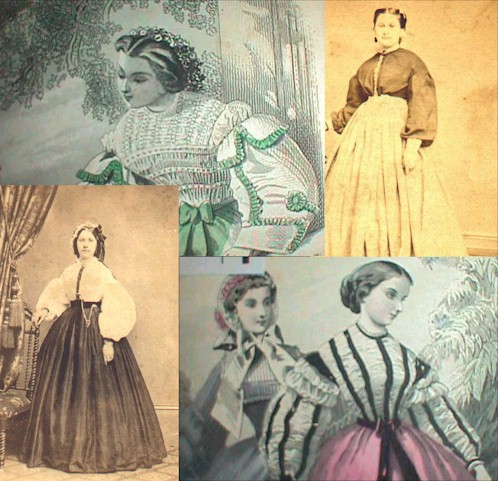
NECKLINES
Beadle's Guide to Dress Making and Millinery, Page 32.
Regarding necklines Mrs Pullan has this to say,
"The neck of the dress should first be cut to suit the figure, leaving only just enough to turn in. No part of the dress is more variously made, although it presents the same uniform appearance."
Further down the page she goes on to say;
"Others like it to be close up to the throat; and we have known some who were very particular, who would have small standing collars set on, in order to make embroidered ones above them lie nicely."
TRAVELING DRESSES
Beadle's Guide to Dress Making and Millinery, Page 52.
Regarding traveling dresses, Mrs Pullan has this to say,
In their traveling toilet, American women are superior to all others. Of course, there are exceptions to the rule; but, generally speaking, whatever the season, their traveling dresses are well chosen. Nothing strikes a stranger with more pleasurable surprise than the sight of ladies dressed for a journey, with their quiet, elegant, neutral colored dresses and mantles, and bonnets of the same hue. with just a soupcon of a bright color round the face.
A SLAVE TO FASHION
Here is what Mrs. Pullan has to say about blindly following fashion on page 24 of The Guide to Dress Making and Millinery, Nov. 1860.
A moderate compliance with existing modes is always desirable, but it should never be carried so far as to outrage the proprieties of life, or to interfere with either comfort or health. The idea in making the shoulder seams come so low on the arms girded to the sides in a garment which is all but a strait jacket.
If Fashion, therefore as interpreted by third rate dress makers, for the leading artistes are rarely guilty of these vulgar absurdities, orders us to have waists that give no room for the lungs to play, or for the stomach to perform its office, or to put ourselves in the above mentioned strait waistcoats, or to drag rich silks trailing through the muddy streets, it is our business, as sensible women to rebel against such preposterous commands, and only follow fashion so long as she and reason do not walk in precisely opposite paths.
On page 35, She is giving instructions as to attaching the bodice to a skirt and has this to say;
The body must be Trimmed before the skirt is put on, and here individual taste, as well as fashion, must be brought into exercise.
PIPING AND CORDING
Beadle's Guide to Dress Making and Millinery, Page 32.
Regarding piping Mrs Pullan has this to say;
The next process is to finish the top, pipe or cord the arm holes, and put a band or cord on the waist.
ORIGINAL FASHION PLATES OF WALKING DRESSES
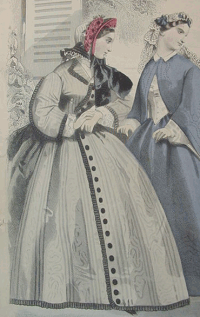
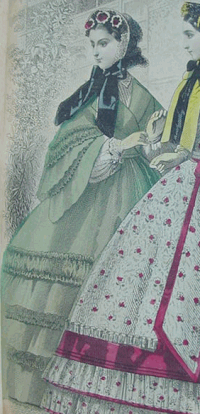
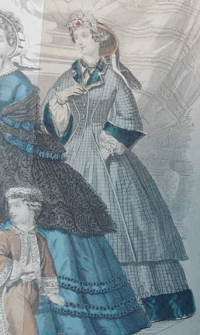
The 3 photos above are from left to right,
Petterson's March 1862 Fashion Plate.
Petterson's March 1861 Fashion Plate.
And Godey's May 1862 Fashion Plate figure #5.
In the descriptive text of each of these figures they are all listed as WALKING DRESSES.
You can easily see they have but few similarities. But these are the most compatible with the description of what a walking dress should be.
There are many others that are listed in the Original Fashion Plates as Walking Dresses that bare no resemblance at all to any of these. In fact some are highly ornate.
ZOUAVE JACKETS
Petterson's Ladies Magazine, April 1862, page 348.
There have been but few new goods imported this season, economy being the order of the day. Old dresses are made to look like new, as mearly as possible. Skirts worn out at the bottom are renewed or lengthened by a bias band, plaiting or ruffle, or silk of black or some color contrasting well with the dress. in this way two old dresses often make on stylish new one. The antiquated bodies, or worn out bodies are discarded, and jaunty Zouave jackets with white shirt bodies and sleeves, or Garibaldi shirts take there place. As the season advances, pique or Marseilles will take the place of silk or flannel for these articles.
From the book,
ANNIE HARPER'S JOURNAL. Page 14
From her personal experiences, written 11 years after the war.
Your grandpa brought us in some fine white linen and black silk coats for men, and the way in which they were transformed into Zouave Jackets was the admiration of all our young friends. Our linen collars were replenished from scraps left from the white coats, and were eyed with envy.
Frank Leslie's News Paper, Dec. 7, 1861
This ad appears on page 47, the back inside cover.
SPLENDID WINTER FASHIONS
and Splendid Novelties in Dress.
MME. DEMOREST'S QUARTERLY MIRROR OF FASHIONS.
Ladies take notice of the following facts, proving it to be the largest, Best and most reliable fashion Magazine published in the world, viz:
Very large and magnificent colored steel fashion plate, containing 9 figures; Large and elegant plate of cloaks with 6 figures; Plate of dresses 9 figures; Three full size patterns, and nearly 100 fine engravings of all the latest novelties in dress, both for ladies and children, with valuable and reliable information. Yearly, with a valuable premium $1. Single copies 25 cents. without the plates and full size patterns, 10 cts.
Published at MME. DEMOREST'S Emporium, 473 Broadway and sold everywhere. or sent by mail. Every lady will find it very valuable. To mothers, milliners or dressmakers it is almost indispensable. The three full sized patterns comprise the latest and best cloak, sleeve and ladies Zouave jacket and alone are worth more than double the cost of the magazine.
PADDING FOR DRESSES AND BODICES
Beadle's Guide to Dress Making and Millinery, Page 26.
Mrs Pullan has this to say regarding padding.
"If padding is to be used, which it should be much more sparingly and rationally than it is now, an inch or more extra should be allowed for it (in the pattern measurements)."
On page 31 Mrs. Pullan says this,
"Padding, when necessary, should be used sparingly. It never answers to put it between the lining and cover as it works its way through, and makes the dress look fluffy."
She goes on to say, " But the frightful pads which are sometimes put in dresses across the bosom are positive deformities."
ELASTIC
Peterson's Magazine, Dec. 1862, Page 473
Instructions for making a ladies Necessaire, or as most of us would call it, a chatelaine.
Under the heading materials needed you will find this: 3 1/2 yards of sarsnet ribbon, about 1 1/2 inch wide; 1 skein of fine black purse silk; quarter of a yard of Black Elastic.
Peterson's Magazine, March 1863, Page 239
Instructions for making a ladies Anklet.
The anklet is to be worn just above the boot, and is made of kid, lined with flannel, the whole bound with galloon. Where it fastens on the outside of the ankle, it may either have eyelets put in, and lace on buttons and loops of gum elastic.
Beadle's Guide to Dress Making and Millinery, Nov. 1860, Page 38.
"Bishop sleeves are also cut so that there is a little fullness on the outer side at the elbow. They should always be cut of a very ample length; otherwise they will be sure to drag at the seam, when the arm is extended. We have seen them finished, very prettily and comfortably with a few rows of elastic round the wrist instead of a wristband."
Meriam-Websters provides us with a few more details on elastic.
Function: noun
Date: 1847
1. Easily stretched rubber usually prepared in cords, strings, or bands.
LEAF COLLECTING
Maggie Lindsley's Journal, Nashville Tenn. 1864, Page 16
"Fannie Webster came out this morning in quest of autumn leaves. I persuaded her to stay all day, which we spent mostly in the woods and groves,-with the children assisting of course,-gathering brilliant treasures.
HOOP SKIRTS OR CRINOLINES
From the book;
A BLOCKADED FAMILY IN SOUTHERN ALABAMA by Parthenia Antoinette Hague
Speaking of her life as a teacher in rural southern Alabama where she spent the entire period of the war, written 20 years after the war, Page 113.
The making of hoop-skirts which were worn extensively before, as well as during, and even for some time after hostilities between the north and the south was not neglected. One of the ladies of our county devised a means of weaving the hoopskirt on the common house loom.
Emerson's United States Magazine
July 1857, Page 108
A HOOP CATASTROPHE
The Richmond Whig says: a few Sundays ago, a modest young gentleman of our acquaintance attended the morning service in one of our fashionable churches.
He was kindly shown into a luxuriously cushioned pew, and had hardly settled himself and taken an observation of his neighbors, before a beautiful young lady entered , and, with a graceful wave of the hand preventing our friend from rising to give her a place, quietly sunk into a seat near the end. When a hymn was given out, she skillfully found the page: and, with a sweet smile that set his heart a thumping handed her neighbor the book. The minster raised his hands in prayer, and the fair girl knelt; and in this posture perplexed her friend which most to admire, her beauty or her devoutness. Presently the prayer was concluded, and the congregation resumed their seats.
Our friend respectfully raised his eyes from the fair form he had been so earnestly scanning, lest when she looked up she would detect him staring at her. After a couple of seconds, he darted a furtive glance at the charmer, and was astonished to see her still on her knees. He looked closely, and saw that she was much affected trembling in violent agitation, no doubt from the eloquent power of the preacher.
Deeply sympathizing, he watched her closely. Her emotion became more violent; reaching hand behind her, she would convulsively grasp her clothing and strain as it were to rend the brilliant fabric of her dress. The sight was exceedingly painful to behold, but he still gazed, like one entranced, with wonder and astonishment. After a minute, the lady raised her face, heretofore concealed in the cushion, and with her hand made an unmistakable beckon to our friend. He quickly moved along the pew toward her, and inclined his ear, as she evidently wished to say something. "Please help me, Sir," she whispered; "my dress has caught, and I can't get up." A brief examination revealed the cause of the difficulty; the fair girl wore fashionable high heeled shoes; kneeling upon both knees, those heels of course stuck out at right angles. and in this position the highest hoop of her new-fangled skirt caught over them, and thus rendered it impossible for here to raise herself or straighten her limbs. The more she struggled the tighter was she bound; so she was constrained to call for help. This was immediately, if not scientifically, rendered; and when the next prayer was made she merely inclined herself upon the back of the front pew, thinking no doubt, that she was not in praying costume.
Emerson's United States Magazine
July 1857, Page 108
HOOPS SAVED HER
As the steamer Commonwealth came alongside the wharf at New London on Friday night, on the passage from Norwich to New York, a lady walked overboard, and would have been drowned but for the hoops in her dress, which rendered the same somewhat balloon-ish, and withal answered the purpose of a more complicated life preserver.. The night was very dark, and it was nearly half and hour before she cold be extricated from her perilous situation, during which time the hoops were sufficiently strong to buoy her up and prevent her from sinking.
LADY'S SHOES & BOOTS
Beadle's Guide to Dress Making and Millinery, Nov. 1860.
Page 76.
"Mules; Slippers without heels, fit only for the bedroom."
"Pantoufes; Slippers suitable for breakfast wear."
"Douillet; Quilted shoes."
"Souliers a Cordon; Evening slippers with strings."
"Soulires Louis XV; Slippers with high heels-full dress."
"Soulires de Bapteme; Getting up shoes, normally very ornamental."
"Souliers hauts Anglais; Shoes coming up the ankle and tying-walking shoes."
"Bottinea toute etoffe; To lace, all cloth or prunella."
"Bottines tout claquer; To button-foxed all round."
"Bottines touts bouts; To lace-tipped."
From the book;
A BLOCKADED FAMILY IN SOUTHERN ALABAMA by Parthenia Antoinette Hague
Speaking of her life as a teacher in rural southern Alabama where she spent the entire period of the war, written 20 years after the war, Page 36.
The best and heaviest leather was used for making shoes for the slaves, as their work as out of doors as a rule, and heavy brogans could not be bought.
Page 37.
I remember very plainly when one of Mr. G----s daughters and I first wore swine skin shoes.
Further down the page.
But swine skin leather was very extensible, and our shoes spread out quite flat by the time we had worn them a day or so.
We stepped back into our shoes made of home spun.
From the book;
A BLOCKADED FAMILY IN SOUTHERN ALABAMA by Parthenia Antoinette Hague
Speaking of her life as a teacher in rural southern Alabama where she spent the entire period of the war, written 20 years after the war, Page 52.
Our shoes, particularly those of women and children, were made of cloth, or knit. Some one had learned to knit slippers and it was not long before most of the women of our settlement had a pair of slippers on the
knitting needles. They were knit of our homespun thread, either cotton or wool, which was for slippers generally dyed a dark brown, gray, or black.
When taken off the needles, the slippers or shoes were lined with cloth or suitable texture. The upper edges were bound with strips of cloth, or color to blend with the hue of the knit work. A rosette was formed of some stray bits of ribbon, or scraps of fine bits of merino or silk, and placed on the uppers of the slippers; then there were ready for the soles.
We explored scrap bags for pieces of cassimere, merino, broadcloth or other heavy fine twilled goods, to make our Sunday Shoes, Home woven jeans and heavy plain cloth had to answer for everyday.
They were sent to the shoemaker to have them soled.
Page 91.
A steamer had run the blockade, The store in Eufaula received among other things, " a few pair of black morocco shoes, lined with red and deep blue leather, laced high and scalloped around the top edge".
From the book,
ANNIE HARPER'S JOURNAL. Page 19
From her personal experiences, written 11 years after the war.
After the fall of Natchez to the Union forces, when northern merchant men arrived to fill the void of sundries to the local inhabitants.
Mrs Harper has this to say regarding the women’s shoes offered for sale.
"The stock of ladies shoes excited our mirth, as fours were the smallest sizes we could find, and we would enjoy the shopkeepers chagrin after a constant demand for one's and two's found no response.
They would grumble that they had heard Southern women had small feet but had never believed it.
True Tales of the South At War
Dairy of a Refugee in Richmond, Page 172.
August 22, 1864
Just been on a shopping expedition for may sister and niece, and spent $1500. in about an hour. I gave $110. for ladies's morocco boots.
Return to WORK / CAMP DRESSES on Page 3
Click here for TEA DRESSES on page 5
Return to LADIES FASHIONS home page
E-mail us
Call us from 9 A.M till 7 P.M. at 931-389-6294 or use our 24 hour fax line 931-389-6294
This site designed and created by Blockade Runner Publishing
Copyright © 2003 - No portions of this website may be redistributed in any form without expressed written permission from Blockade Runner Inc.



 It is always a pleasure for us to see our workpeople, and especially our comely young women, dressed NEAT and TIDY; nor should we, as has already been declared in a notice that has been put up earlier, wish to interfere with the fashion of their dress, whatever it may be, so long as their dress does not interfere with their work, or the work of those near them in our employ.
The present ugly fashion of HOOPS, or CRINOLINE, as it is called, is, however, quite unfitted for the work of our Factory. Among the Power Loomsit is almost impossible, and highly dangerous; among the carding and other machines it greatly impedes the free passage of Overseers, Wasters, &c., and is inconvenient to all. It is equally inconvenient, and still more mischievous, by bringing the dress against Spindles, while also it sometimes becomes shockingly indecent when people are standing upon the sliders.
It is always a pleasure for us to see our workpeople, and especially our comely young women, dressed NEAT and TIDY; nor should we, as has already been declared in a notice that has been put up earlier, wish to interfere with the fashion of their dress, whatever it may be, so long as their dress does not interfere with their work, or the work of those near them in our employ.
The present ugly fashion of HOOPS, or CRINOLINE, as it is called, is, however, quite unfitted for the work of our Factory. Among the Power Loomsit is almost impossible, and highly dangerous; among the carding and other machines it greatly impedes the free passage of Overseers, Wasters, &c., and is inconvenient to all. It is equally inconvenient, and still more mischievous, by bringing the dress against Spindles, while also it sometimes becomes shockingly indecent when people are standing upon the sliders.


 Beadle's page 47.
Beadle's page 47. From Beadle's Dime guide to Dress-Making and Millinery by Mrs. Marion M. Pullan---Published Nov. 1860.
From Beadle's Dime guide to Dress-Making and Millinery by Mrs. Marion M. Pullan---Published Nov. 1860. The photo to your right is the upper portion of a "Trade Card" as they are known in the advertising business.
The photo to your right is the upper portion of a "Trade Card" as they are known in the advertising business. "By 1860, Singer Sewing Machine Company was the largest producer and distributor with over 110,000 machines that year."
Source, Sewing Tools & Trinkets. A collectors guide by Helen Lester Thompson. Printed by Collector Books 1997.
"By 1860, Singer Sewing Machine Company was the largest producer and distributor with over 110,000 machines that year."
Source, Sewing Tools & Trinkets. A collectors guide by Helen Lester Thompson. Printed by Collector Books 1997. Sales Room, No. 480 Broadway, New York.
Sales Room, No. 480 Broadway, New York. The EVIL COLOR RED, or at least that is how many of our fellow Civil War enthusiast like to portray it. The fact of the matter is nothing could be further from the truth.
The EVIL COLOR RED, or at least that is how many of our fellow Civil War enthusiast like to portray it. The fact of the matter is nothing could be further from the truth.


